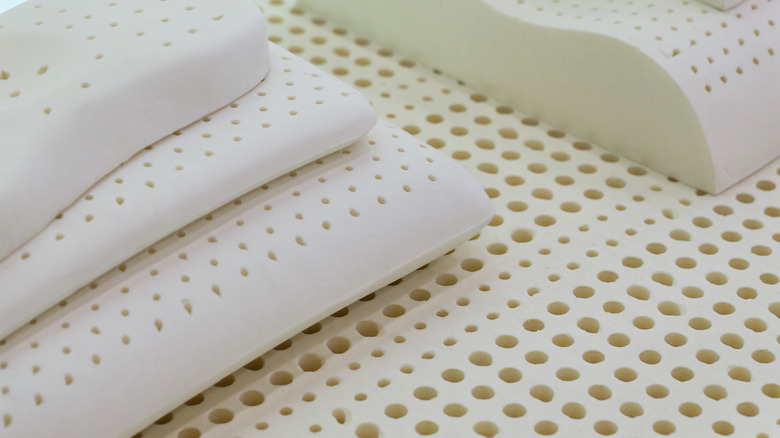Should You Make The Switch To A Latex Pillow?
We may receive a commission on purchases made from links.
There's truly no better feeling than sinking into bed after an exhausting day. But getting those restful hours of sleep? That requires more than just choosing the best mattress on the market. You'll need the finest pillow, too. One that not only cushions your head and neck in a cloud of comfort but also prevents overheating and doesn't trigger allergic reactions (to name a few factors). This leads us right to the material of choice — latex. Some swear by latex pillows, insisting they are heavenly and far superior to any other bedding. Meanwhile, other sleepers find the feel of the stuffing difficult to get used to.
Latex pillows have a foam filling made from the milk-like sap of rubber trees. Hence, they are eco-friendly, non-toxic, and a natural alternative to chemically produced pillow stuffing, such as memory foam and polyester. You'll want to be careful, however, as some latex pillows include a mix of synthetic materials or have a completely artificial fill. These don't boast the same quality and durability as natural latex. Not to mention, they tend to off-gas, releasing fumes that can smell foul. Always look for latex pillows that are certified by the Global Organic Latex Standard (GOLS) to confirm they're all-natural. But of course, just because this pillow material comes from nature doesn't guarantee it'll suit your sleeping needs. There are other things to consider when picking pillows for your bed, particularly with latex ones.
Weighing the pros and cons of latex pillows
Starting with the texture — latex pillows have a quick-bouncing, squishy feel to them. While advantageous for those who like their pillows soft, this could be a dealbreaker if you're a side sleeper or need extra support. Although latex pillows do have varying levels of firmness, from soft headrests made with shredded latex to denser ones with solid compact inserts. On the plus side, these pillows offer great shape retention, so you rarely ever need to fluff them. They're also more durable than standard cushions, lasting up to 7 years or more — though we recommend changing out your pillows more often for the sake of cleanliness. Further, if you're tired of waking up to a stuffy nose and itchy eyes, latex pillows might help. They are naturally hypoallergenic and resistant to mildew and mold. At the same time, the foam's porous structure makes this material highly breathable, ensuring hot sleepers stay dry and cool throughout the night.
On the not-so-great side of things, latex pillows are typically more expensive. For instance, while the OrganicTextiles Natural Latex Pillow with Cotton Cover costs about $95 for one piece, you could find a pack of memory foam pillows for a fraction of that price. Additionally, latex bedding can't be tossed in the washing machine. The pillows should only be spot-cleaned to prevent warping. And finally, solid latex inserts are quite heavy compared to other fills, so it might not be ideal if you prefer a fluffy, airy headrest. Overall, for a soft, breathable, and all-natural pillow, latex foam is the stuffing of choice.

